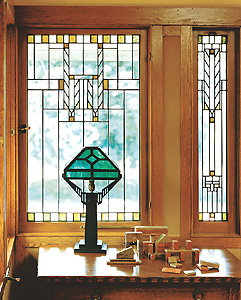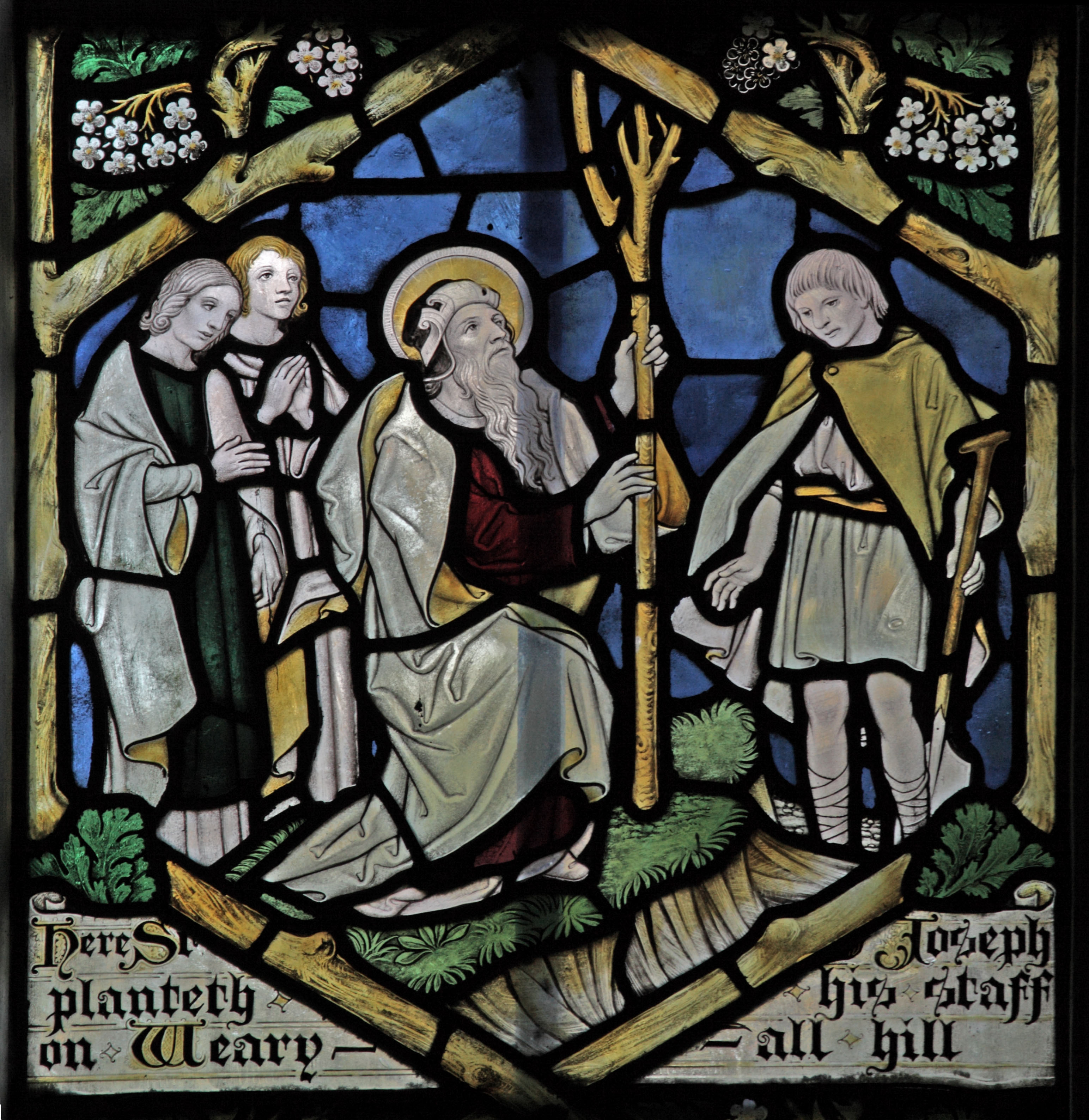Stained glass is colored glass that has been cut into pieces and reassembled to form a picture or decorative design. The pieces are held together by strips of lead. The picture or design shines brightly when the glass is illuminated. However, light must pass through the glass to create this effect. Therefore, stained glass is used chiefly for windows. A well-made stained-glass window glows and sparkles with color in the rays of the sun.

Colorless glass may be painted or chemically treated to look like stained glass. But authentic stained glass is colored during the glassmaking process. The colors are produced by adding certain metal oxides to the other glassmaking ingredients. For example, cobalt oxide may be added to make blue glass, and copper oxide to make red glass.
Most details of stained-glass pictures, such as shadows and facial features, are painted in. But the art of making stained glass is only distantly related to the art of painting. Stained glass achieves its effects mainly through the colors and shapes of the pieces of glass. The outlines formed by the lead strips also add to the effects of stained glass.
How stained-glass windows are made
Most stained-glass windows are designed by professional artists. In some cases, the artist also makes the window. In others, skilled craftworkers do this work under the artist’s supervision.

The artist first makes a sketch of the picture or design to be portrayed by the window. The sketch serves as a model for a full-sized blueprint of the window. On the blueprint, called a cartoon, the artist shows the exact shape and color of each piece of glass. The artist also indicates the location of the lead strips and designates the details to be painted in. The cartoon is then traced onto heavy paper. The artist cuts out the patterns of the pieces of glass and marks each one to indicate its color.
Each paper cutout is placed on a sheet of glass of the designated color, and its outline is traced with a glass-cutter. When the glass is snapped, it breaks neatly along the outlines. After all the pieces have been cut out, they are put in place on the cartoon. The artist then paints the details of the window illustration.
The paint used for the details of stained-glass pictures is an enamel–a mixture of powdered glass, iron oxide, and a liquid, such as oil or water. The liquid makes the enamel flow, and the iron oxide gives it a dark brown color. After the artist has painted in the details of the picture, the pieces are fired in a special furnace called a kiln. The heat bonds the powdered glass and the iron oxide to the surface of the colored glass. After the glass has cooled, the pieces are again put in place on the cartoon.
The pieces of the window are now ready to be joined by means of strips of lead. Lead is used because it is soft and can easily be molded to the shapes of the glass pieces. The lead strips used to join segments of stained glass have a groove along each side and are called cames. The two grooves of a came are fitted over the edges of adjoining pieces of glass. Thus, each came joins several pieces. After all the pieces have been joined, the points where the ends of the cames meet are filled with solder. Putty is forced into the grooves to make them watertight. The finished window is now ready to install.
Large stained-glass windows have a framework of iron bars to hold them in place. The bars divide the window opening into sections. The stained glass for such windows is made in sections that fit the sections of the framework.
History
Early stained-glass windows.
The art of making stained-glass windows developed in western Europe during the Middle Ages. From the beginning, the art was closely allied with that of church-building. Stained-glass windows greatly increased the beauty of a church, but they had a more practical purpose as well. Scenes pictured in sparkling light and glowing colors make a strong impression on many people. Stained-glass windows thus became a powerful force in the teaching and encouragement of religion. Most early windows pictured scenes from the Bible or from the lives of saints.
Only fragments of stained glass have survived from the period before the 1000’s. Five windows in the cathedral of Augsburg, Germany, are believed to be the oldest stained-glass windows in existence. They date from the last half of the 1000’s or the early 1100’s. Each of these windows shows a Biblical prophet.
All stained-glass windows made before the mid-1100’s were relatively small. At that time, churches had to have extremely thick walls to support their lofty domes and arches. In addition, window openings had to be small to avoid weakening the walls. During the early 1100’s, however, architects began to develop a system of roof supports that greatly reduced the stress on the walls. More space could then be devoted to windows. The church of St.-Denis, near Paris, was the first church built in this style of architecture, called Gothic, and the first to have large stained-glass windows. The earliest of these windows were installed in the church in the mid-1100’s. During the next 100 years, many Gothic churches were built in Europe, and the art of making stained-glass windows developed rapidly.
Technical improvements.
Most large stained-glass windows of the 1100’s had a framework of straight iron bars that divided them into rectangular sections. By the early 1200’s, blacksmiths had learned to forge iron bars into curved shapes. Window frameworks then began to have round, as well as rectangular, sections. Round sections of stained glass created beautiful medallion-like patterns in a church window. Huge circular stained-glass windows also became common during the 1200’s. These windows were divided into sections by delicate stonework called tracery. Because of their flowerlike shape, such windows are known as rose windows.
As the Gothic system of roof supports was improved, architects designed churches that had more and larger windows. The Ste.-Chapelle, a church built in Paris during the 1240’s, has walls made almost entirely of stained glass. The windows are separated only by narrow stone frames and extend from just above the floor to the ceiling, a distance of nearly 50 feet (15 meters). More than 100 large stained-glass windows were installed in the Chartres Cathedral during the 1200’s. They include many lovely medallion-style windows and several magnificent rose windows.
The greatest churches of the Middle Ages had many stained-glass windows. But stained glass was expensive, and most churches could afford only a little of it. Then, in the 1300’s, craftworkers discovered that colorless glass, if coated with silver nitrate, becomes stained brilliant yellow when fired. The chemical could be applied inexpensively as a solid coating or in patterns. Windows made of this type of stained glass became common in churches during and after the 1300’s.
Techniques developed in the 1400’s gave artists greater freedom to experiment. One technique involved the use of glass that had only a thin film of color. The film was bonded to the glass during the glassmaking process, but it could be scraped off, exposing the colorless glass underneath. By scraping pictures or designs on the glass, artists produced windows as rich in detail as fine engravings. Also during the 1400’s, artists began to use brightly colored enamels to paint elaborate scenes on colorless glass. After the painted glass was fired, it had nearly the same brilliance as stained glass.
Decline and revival.
The techniques developed during the 1400’s gradually replaced the traditional methods of making stained glass. To make a decorative window, the artist scraped or painted the picture or design on panes of glass. The panes were then installed in the window framework. This method eliminated the need to build a window from many pieces of colored glass and a number of lead strips. However, the windows looked more like paintings than stained glass. By the 1600’s, the art of making stained glass was nearly forgotten.
Interest in the art revived during the 1800’s. Artists mastered the old techniques of making stained glass, and churches again began to have large stained-glass windows. At first, the windows were designed to look as nearly like those of the Middle Ages as possible. But by the early 1900’s, artists had begun to develop new designs and even new uses for stained glass. John La Farge and Louis C. Tiffany were among the leaders of this movement in the United States. Tiffany invented new types of stained glass and used them not only for windows but also for decorative lampshades.
Today, the creation of stained glass ranks as an imaginative, highly developed art. Gifted artists, such as Marc Chagall and Georges Rouault, have designed superb stained-glass windows for modern religious structures. Some artists use techniques similar to those of the Middle Ages. Others have developed new techniques. For example, many stained-glass windows are now made of thick slabs of colored glass. The slabs are cut to shape and then joined with cement rather than with lead.
